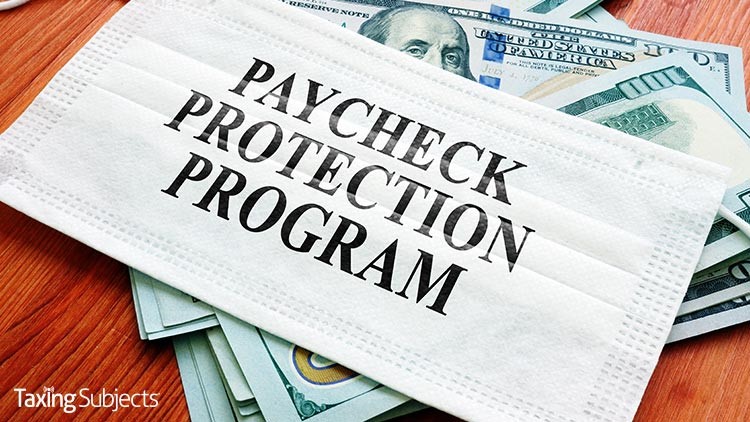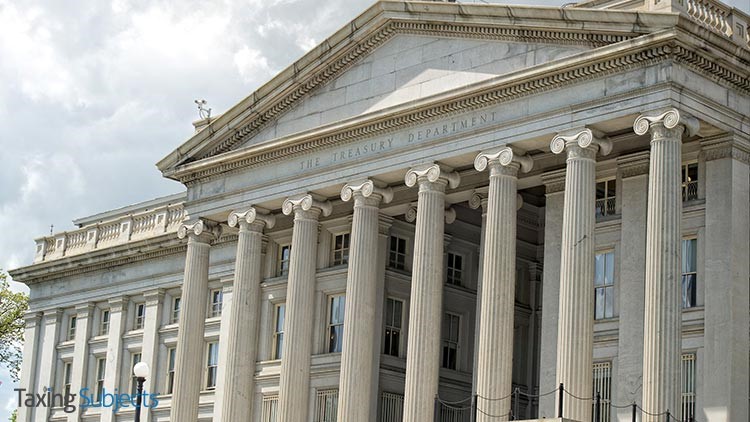by | Jan 8, 2021 | Tax Tips and News
The Internal Revenue Service has eased the cost of participation in the Paycheck Protection Program (PPP) by allowing deductions for the payment of eligible expenses.
The deductions are outlined in guidance issued by the IRS, and are allowed when such payments would result—or be expected to result—in the forgiveness of a covered loan under the Paycheck Protection Program.
The guidance, contained in Revenue Ruling 2021-02, reflects recent changes to law contained in the Tax Relief Act of 2020. This legislation was part of the Consolidated Appropriations Act, 2021 (Act), Public Law 116-260, which was signed into law on Dec. 27, 2020.
The Tax Relief Act of 2020 amended the Coronavirus Aid, Relief, and Economic Security Act (CARES Act) to say that no deduction is denied, no tax attribute is reduced, and no basis increase is denied by reason of the exclusion from gross income of the forgiveness of an eligible recipient’s covered loan.
The change applies for taxable years ending after March 27, 2020.
Revenue Ruling 2021-02 now makes both Notice 2020-32 and Revenue Ruling 2020-27 obsolete.
The outdated guidance disallowed deductions for the payment of eligible expenses when the payment resulted—or could be expected to result—in forgiveness of a covered loan.
For more information about this new guidance, the COVID-related Tax Relief Act of 2020 and other tax changes, visit the IRS website at IRS.gov.
– Story provided by TaxingSubjects.com
by | Jan 7, 2021 | Tax Tips and News
The Internal Revenue Service is reminding tax professionals and taxpayers that employers need to file Form W-2 and other wage statements by Feb. 1, 2021.
The February deadline is also the date employers must get wage statements to their employees.
The timetable is set by law
Employers are required by law to file copies of their Form W-2, Wage and Tax Statement, and Form W-3, Transmittal of Wage and Tax Statements, with the Social Security Administration by Jan. 31.
However, since Jan. 31 falls on a Sunday in 2021, the deadline this year is the next business day, which happens to be Monday, Feb. 1.
Other forms are due on the Feb. 1 date as well. Form 1099-MISC, Miscellaneous Income, and Form 1099-NEC, Non-employee Compensation, are also due to recipients by the Feb.1 date – with some exceptions.
For other due dates that are related to Form 1099, check out the form’s instructions.
Filing fights fraud
Employers who file their wage statements on time help not only themselves, but the IRS as well. The employer avoids late-filing penalties, and the IRS has time to verify the income taxpayers report on their tax returns, which helps prevent fraud.
As far as filing is concerned, e-filing is the most accurate and convenient way to send the forms to the IRS – by far. In fact, those employers who file 250 or more such information returns in a single calendar year must transmit their filings electronically.
Plan and prepare early
Good preparation now can help employers avoid problems later. For instance, employers can start by verifying or updating employee information, such as:
- Names
- Addresses
- Social Security Numbers
- Individual Taxpayer Identification Numbers
Employers should be sure their account information is current and active with the Social Security Administration as soon as possible. Lastly, employers should order paper Form W-2s, if needed.
It should be noted that are no automatic extensions of time to file Forms W-2. The IRS will only grant extensions for very specific reasons.
Employers should read the instructions for Form 8809, Application for Extension of Time to File Information Returns, for more information.
Source: Tax Tip 2021-01
– Story provided by TaxingSubjects.com
by | Jan 7, 2021 | Tax Tips and News
Ask most people what they thought of 2020, and the response is likely to be something like, “disastrous,” “catastrophic” — even “unprecedented.”
Ask IRS Commissioner Chuck Rettig, though, and he might say 2020 was his agency’s finest hour.
The just-departed year, while marked with turmoil and a pandemic, showcased the IRS’ ability to carry out a mission, no matter what the circumstances.
Annual report released
The IRS has released its annual report for 2020, which spotlights its work delivering taxpayer service and continuing compliance efforts in a year that saw the COVID-19 coronavirus challenge all aspects of the agency’s mission.
“Internal Revenue Service Progress Update/Fiscal Year 2020 – Putting Taxpayers First” outlines how the agency overcame difficulties during the pandemic to deliver Economic Impact Payments in record time. At the same time, IRS employees made adjustments to complete a successful filing season despite office closures and the latest tax deadline ever.
“The COVID-19 pandemic presented some of the greatest challenges to the IRS in its history, both in terms of being able to carry out our mission and in protecting the health and safety of taxpayers and our own workforce,” Commissioner Rettig wrote in the report’s opening message and addressed in his ‘A Closer Look’ column. “IRS employees responded admirably by quickly facilitating financial assistance to millions of deserving and needy Americans.”
But the 44-page report isn’t just about the pandemic and overcoming its challenges. It also documents the agency’s progress toward six strategic goals and documents the ongoing effort to modernize the American tax system.
In addition, the 2020 report shows work completed on implementing the Taxpayer First Act.
“Even with all the challenges, we believe we have made great strides during Fiscal Year 2020, but we want to do more,” Rettig said.
Rettig explained that each year the IRS collects more than $3 trillion in taxes and generates approximately 96% of the funding that supports the federal government’s operations.
“My experiences as Commissioner have strengthened my belief that a fully functioning IRS is critical to the success of our nation,” he said. “When citizens can perform their civic duty each year by preparing and filing their taxes and paying only what they should, they help fund critical aspects of the United States ranging from schools and roads to Social Security payments and the nation’s military.”
Service came first
The 2020 Annual Report lays out numerous examples of how IRS employees helped taxpayers during a very challenging year:
- Expanded information and assistance available to taxpayers in additional languages and underserved communities to help deliver Economic Impact Payments and other services.
- Adjusted agency processes through the People First Initiative to help people and businesses encountering payment and other challenges during the pandemic.
- Offered an electronic filing option for amended tax returns with the new Form 1040-X, marking a major milestone to help taxpayers and the tax community.
- Served their communities outside official duties through charitable donations and service projects.
The report also illustrates ways IRS employees worked to maintain the tax system through a strong, visible and robust tax enforcement presence. It says the agency enhanced its criminal investigation and civil enforcement efforts with an expanded use of data analysis and artificial intelligence across all lanes, from selection to examination.
In the Progress Update section, the report touts the IRS’ work partnering on landmark criminal investigations that brought down child pornography, drug and terrorist organizations.
The IRS, the report explains, continues to increase its pursuit of those who promote and use abusive tax shelters – including syndicated conservation easements. The agency has seen successful Tax Court results on these cases, as well as completion of its first settlement initiative.
The report also details the IRS’ Integrated Business Modernization Plan, which is a roadmap that guides the agency move to offer best-in-class customer service. This level of service is what people are accustomed to have when dealing with an online retailer or financial institution.
“As we move into the future, the name of the game for the IRS will continue to be innovation, creativity and service to the people of our country to make their world better,” Rettig said. “Given all we’ve accomplished together in 2020 and all we’re working to achieve, we believe the future looks bright for the IRS, the tax system and our nation.”
– Story provided by TaxingSubjects.com
by | Jan 5, 2021 | Tax Tips and News
The second set of Economic Impact Payments are already showing up in eligible Americans’ bank accounts, but some may encounter problems with their direct payment. Rather than picking up the phone, the Internal Revenue Service today advised taxpayers to instead visit the IRS website for answers since “IRS phone assistors do not have additional information beyond what’s on IRS.gov.”
As with the CARES Act-provided Economic Impact Payments, the IRS expects there could be some confusion with the latest direct payments issued by the Treasury Department and IRS. From unavailable funds to less-than-anticipated payouts, the agency aims to set expectations and answer as many questions as possible at this early stage in the process.
“The direct deposit payments may take several days to post to individual accounts,” the IRS says. “Some Americans may have seen the direct deposit payments as pending or as provisional payments in their accounts before the scheduled payment date of January 4, 2021, which is the official date funds are available.”
That particular issue should have worked itself out for the earliest direct-deposit recipients, but those who are expecting paper checks won’t have the luxury of receiving a real-time alert from a mobile banking app when the check arrives in their mailbox. That’s why those recipients will need to regularly check the Get My Payment online tool and keep a close eye on their mailbox.
(Note: While distribution of checks began on December 30, the IRS expects to take until at least the middle of January to finish sending EIPs—and it could take even longer for eligible individuals living overseas.)
What if I don’t receive an Economic Impact Payment?
Economic Impact Payment-eligible Americans who receive a smaller-than-expected payment—or no payment at all—can claim the Recovery Rebate Credit on their tax year 2020 return. Since this credit covers both EIPs that were authorized in 2020, it helps ensure that all eligible Americans eventually get the financial relief they’re due.
“Because of the speed at which IRS issued this second round of payments, some payments may have been sent to an account that may be closed or no longer active,” the IRS explains. “By law, the financial institution must return the payment to the IRS, they cannot hold and issue the payment to an individual when the account is no longer active. While the IRS is exploring options to correct these payments, if you have not received your full payment by the time you file your 2020 tax return, you may claim the Recovery Rebate Credit on your tax return.”
Where can I find more information about Economic Impact Payments?
Aside from the Get My Payments tool, the IRS says the following webpages contain important information about coronavirus tax relief:
Source: IR-2021-01
– Story provided by TaxingSubjects.com
by | Jan 1, 2021 | Tax Tips and News
The Internal Revenue Service this week published a safe harbor for the management or operation of qualified residential living facilities in Revenue Procedure 2021-9.
Trades and businesses managing or operating a residential living facility—as defined in the text of the revenue procedure—can “[treat] it as a real property trade or business, solely for purposes of qualifying to make the election under Internal Revenue Code section 163(j)(7)(B) to be an electing real property trade or business.”
The residential living facility must meet three criteria to qualify for the safe harbor:
- [Consist] of multiple rental dwelling units within one or more buildings or structures that generally serve as primary residences on a permanent or semipermanent basis to individual customers or patients;
- [Provide] supplemental assistive, nursing, or other routine medical services; and
- [Have] an average period of customer or patient use of individual rental dwelling units of 30 days or more.
To determine the average period of customer or patient use, the IRS says the trade or business will generally need to divide:
- the sum of the total number of days in the taxable year that each customer or patient resides in a rental dwelling unit of the residential living facility, which may be determined by reference to a rental contract or other formal written lease agreement, or by the number of days paid for by Medicare or Medicaid;
by
- the total number of individual residential customers or patients that reside in all of the rental dwelling units of the facility for the taxable year.
For the full text of the revenue procedure, check out this page on the IRS website: IRS.gov/pub/irs-drop/rp-21-09.pdf.
Source: Rev Proc 2021-9
– Story provided by TaxingSubjects.com
by | Dec 31, 2020 | Tax Tips and News
The Treasury Department and Internal Revenue Service yesterday evening announced that the next set of Economic Impact Payments are officially on the way. According to the IRS release, the agency aimed to start direct deposits later that night and send the first round of paper checks today.
What do I have to do to receive a $600 Economic Impact Payment?
Most eligible Americans will automatically receive their direct payment in the same form as the first Economic Impact Payment, whether by direct deposit, Direct Express card, or paper check or debit card. However, the IRS notes that some who previously received an EIP by check could instead get a debit card for this payment.
The IRS says the following groups will automatically receive payments:
- Eligible taxpayers who filed a 2019 tax return
- Social Security retirement recipients
- Survivor or disability benefits (SSDI) recipients
- Railroad Retirement benefits recipients
- Supplemental Security Income (SSI) benefits recipients
- Veterans Affairs benefits recipients
- Non-Filers: Enter Payment Info Here online tool registrants who received an EIP
- Non-filers who successfully submitted a simplified tax return
Qualifying Americans who do not normally file a tax return and who are not included in any of the above groups will need to file a tax year 2020 return and claim the Recovery Rebate Credit to receive their payment.
After you receive an EIP, expect an IRS notice confirming the amount of the payment.
Who is eligible for the $600 Economic Impact Payment?
Eligibility requirements are generally the same as the first round of EIPs:
- $600 for individuals with a 2019 AGI that does not exceed $75,000
- $1,200 for married couples filing jointly with a 2019 AGI that does not exceed $150,000
When filers’ AGI exceeds those thresholds, the amount of the direct payment begins to phase out.
While those thresholds remain the same, the IRS says that—aside from the amount of the payment—there is another major difference between the first and second EIPs: Married filing jointly returns for couples that include only one valid Social Security Number holder are now eligible for the $600 EIP.
“In this situation, these families will now be eligible to receive payments for the taxpayers and qualifying children of the family who have work-eligible SSNs,” the IRS explains. “People in this group who don’t receive an Economic Impact Payment can claim this when they file their 2020 taxes under the Recovery Rebate Credit.”
What if I am eligible but haven’t received either Economic Impact Payment by December 31, 2020?
The IRS says that those who qualify but did not receive either EIP in 2020 can claim a special tax credit when filing a tax year 2020 return. “People will see the Economic Impact Payments (EIP) referred to as the Recovery Rebate Credit (RRC) on Form 1040 or Form 1040-SR since the EIPs are an advance payment of the RRC,” the IRS says. Specific to the RRC, the IRS notes that many taxpayers—even recent college grads—may be able to claim the credit, so they recommend confirming eligibility requirements prior to filing.
What happens if Congress approves a larger direct payment this week?
While the majority leader yesterday declined to bring an up-or-down vote for increasing direct payments to $2,000 to the floor of the Senate, it’s still possible they could pass an increase before the end of the week. If that happens, the IRS says, “the Economic Impact Payments that have been issued will be topped up as quickly as possible.”
Sources: “Treasury and IRS begin delivering second round of Economic Impact Payments to millions of Americans”
– Story provided by TaxingSubjects.com






